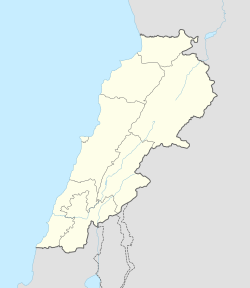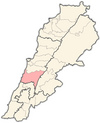
Fakhr al-Din ibn Qurqumaz Ma'n, commonly known as Fakhr al-Din II, was the paramount Druze emir of Mount Lebanon from the Ma'n dynasty, an Ottoman governor of Sidon-Beirut and Safed, and the strongman over much of the Levant from the 1620s to 1633. For uniting modern Lebanon's constituent parts and communities, especially the Druze and the Maronites, under a single authority for the first time in history, he is generally regarded as the country's founder. Although he ruled in the name of the Ottomans, he acted with considerable autonomy and developed close ties with European powers in defiance of the Ottoman imperial government.
The Jumblatt family, also transliterated as Joumblatt and Junblat) is a prominent Druze family based in the Chouf area of Mount Lebanon that has dominated Druze politics since the 18th century. The current head of the family is veteran politician Walid Jumblatt, the son and successor of Kamal Jumblatt, one of the most influential figures in modern Lebanese politics. Other members of the family have contributed to cultural, economic and social life in Lebanon. Khaled Jumblatt, a distant cousin of Walid Jumblatt, held the position of minister of economy and was a prominent politician in Lebanon for many years until his death in 1993. Besides the Chouf, the family owns mansions and villas within the distinguished Clemenceau area of Beirut and in the northwest area of Sidon.

Chouf is a historic region of Lebanon, as well as an administrative district in the governorate (muhafazat) of Mount Lebanon.

Deir al-Qamar, meaning "Monastery of the Moon" is a village south-east of Beirut in south-central Lebanon. It is located five kilometres outside of Beiteddine in the Chouf District of the Mount Lebanon Governorate at 800 m of average altitude.

Beit ed-Dine, also known as Btaddine is a small town and the administrative capital of the Chouf District in the Mount Lebanon Governorate in Lebanon. The town is located 45 kilometers southeast of Beirut, and near the town of Deir el-Qamar from which it is separated by a steep valley. It had 1,613 registered voters in 2010 and its inhabitants are predominantly Christians from the Maronite, Melkite and Greek Orthodox denominations. Beit ed-Dine's total land area consists of 244 hectares and its average elevation is 860 meters above sea level.

Aley is a district (qadaa) in Mount Lebanon, Lebanon, to the south-east of the Lebanon's capital Beirut. The capital is Aley. Aley city was previously known as the "bride of the summers" during the 1960 and 1970s, when Aley and neighboring Bhamdoune were attractive tourist locations for Lebanese emigres and local Lebanese
Sheikh Jamal al-Din Hamdan was a Lebanese Druze Sheikh living in the nineteenth century in Mount Lebanon in Bater, Chouf District.

The Shihab dynasty was an Arab family whose members served as the paramount tax farmers and local chiefs of Mount Lebanon from the early 18th to mid-19th century, during Ottoman rule. Their reign began in 1697 after the death of the last Ma'nid chief. The family centralized control over Mount Lebanon, destroying the feudal power of the mostly Druze lords and cultivating the Maronite clergy as an alternative power base of the emirate. The Shihab family allied with Muhammad Ali of Egypt during his occupation of Syria, but was deposed in 1840 when the Egyptians were driven out by an Ottoman-European alliance, leading soon after to the dissolution of the Shihab emirate. Despite losing territorial control, the family remains influential in modern Lebanon, with some members having reached high political office.

The Ma'n dynasty, also known as the Ma'nids, were a family of Druze chiefs of Arab stock based in the rugged Chouf area of southern Mount Lebanon who were politically prominent in the 15th–17th centuries. Traditional Lebanese histories date the family's arrival in the Chouf to the 12th century, when they were held to have struggled against the Crusader lords of Beirut and Sidon alongside their Druze allies, the Tanukh Buhturids. They may have been part of a wider movement by the Muslim rulers of Damascus to settle militarized Arab tribesmen in Mount Lebanon as a buffer against the Crusader strongholds along the Levantine coast. Fakhr al-Din Uthman ibn Yunus Ma'n, the first member of the family whose historicity is certain, was the "emir of the Chouf", according to contemporary sources and, despite the non-use of mosques by the Druze, founded the Fakhreddine Mosque in the family's stronghold of Deir al-Qamar.

The 1860 civil conflict in Mount Lebanon and Damascus was a civil conflict in Mount Lebanon during Ottoman rule in 1860–1861 fought mainly between the local Druze and Christians. Following decisive Druze victories and massacres against the Christians, the conflict spilled over into other parts of Ottoman Syria, particularly Damascus, where thousands of Christian residents were killed by Muslim and Druze militiamen. The fighting precipitated a French-led international military intervention.

Baakleen or Baakline is a major Druze town located in Mount Lebanon, Chouf District, 45 kilometers southeast of Beirut. Altitude 850 – 920 meters high, population is 30,000, area 14 square km, number of homes 2,870. Bordering Towns: Deir El Qamar, Beit Eddine, Aynbal, Deir Dourit, Symkanieh, and Jahlieh.
Brih, Breeh is a village in the Chouf District in Mount Lebanon region, Lebanon. Brih is located 53 kilometres (33 mi) away from Beirut, the capital of Lebanon. It sits at an altitude of 800–1,100 metres (2,600–3,600 ft) above sea level and has an overall surface area of 305 hectares (1.18 sq mi).
The Mountain War, also known as the War of the Mountain and Guerre de la Montagne in French, was a subconflict between the 1982–83 phase of the Lebanese Civil War and the 1984–89 phase of the Lebanese Civil War, which occurred at the mountainous Chouf District located south-east of the Lebanese Capital Beirut. It pitted the Christian Lebanese Forces militia (LF) and the official Lebanese Armed Forces (LAF) against a coalition of anti-government Muslim leftist militias led by the Druze Progressive Socialist Party (PSP), backed by the Palestine Liberation Organization (PLO) and Syria. Hostilities began when the LF and the LAF entered the predominantly Druze Chouf district to bring back the region under government control, only to be met with fierce resistance from local Druze militias and their allies. The PSP leader Walid Jumblatt's persistence to join the central government and his instigation of a wider opposition faction led to disintegration of the already fragile LAF and the eventual collapse of the government under President Amin Gemayel.
Deir El Aachayer is a village north of Rashaya, in the Rashaya District and south of the Beqaa Governorate in Lebanon.

Wiam Maher Najib Wahhab is a Lebanese Druze politician and journalist from Jahlieh, Chouf District, and the founder of the Arab Unification Party.
Bakka, Bekka or Beka is a village and municipality situated 85 kilometres (53 mi) east of Beirut in the Rashaya District of the Beqaa Governorate in Lebanon. The population of the village is Sunni.
Fakhr al-Din Uthman ibn al-Hajj Yunis Ibn Ma'n also known as Fakhr al-Din I, was the Druze emir of the Chouf district in southern Mount Lebanon from at least the early 1490s until his death in 1506, during Mamluk rule. He was the head of the Ma'n family, whose emirs controlled the Chouf from 1120. He is credited by an inscription for building a mosque in Deir al-Qamar in 1493. He was briefly imprisoned by the Mamluk authorities in 1505 in relation to his alliance with the Bani al-Hansh clan against the Mamluk-appointed, Druze governor of Beirut.
The Alam al-Dins, also spelled Alamuddin or Alameddine, were a Druze family that intermittently held or contested the paramount chieftainship of the Druze districts of Mount Lebanon in opposition to the Ma'n and Shihab families in the late 17th–early 18th centuries during Ottoman rule. Their origins were obscure with different accounts claiming or proposing Tanukhid or Ma'nid ancestry. From at least the early 17th century they were the traditional leaders of the Yaman faction among the Druzes, which stood in opposition to the Qays, led by the Tanukhid Buhturs, traditional chiefs of the Gharb area south of Beirut, and the Ma'ns. A likely chief of the family, Muzaffar al-Andari, led the Druze opposition to the powerful Ma'nid leader Fakhr al-Din II until reconciling with him in 1623.
Iqlim al-Kharrub is a geographic region in the western part of the Chouf District. Its inhabitants are mostly Sunni Muslims.
Aḥmad ibn Mulḥim ibn Yunus Maʾn was the paramount emir of the Druze in Mount Lebanon and the tax farmer of the subdistricts of the Chouf, Matn, Gharb and Jurd from 1667 until his death in 1697. He was the last member of the Ma'n dynasty, after which paramount leadership passed to his marital relatives from the Shihab dynasty.











